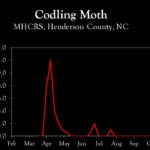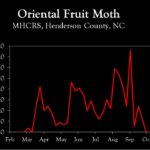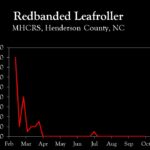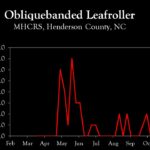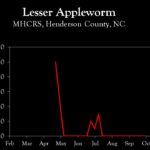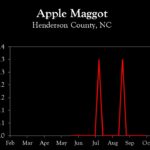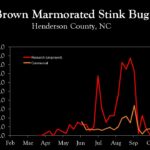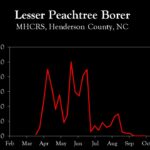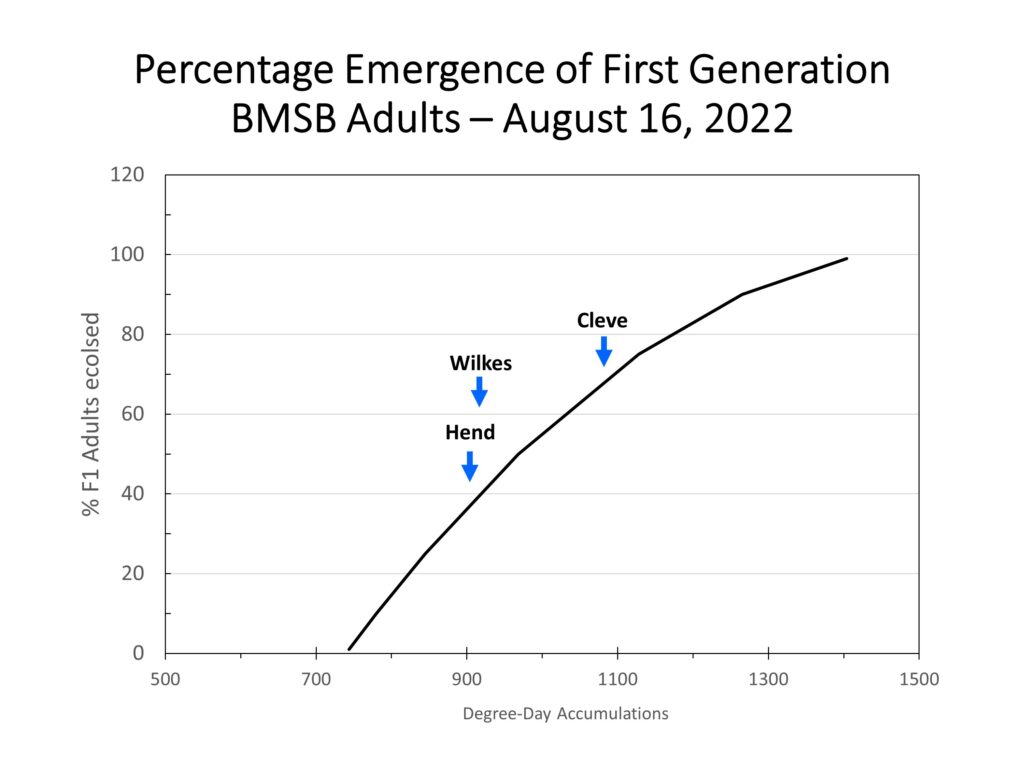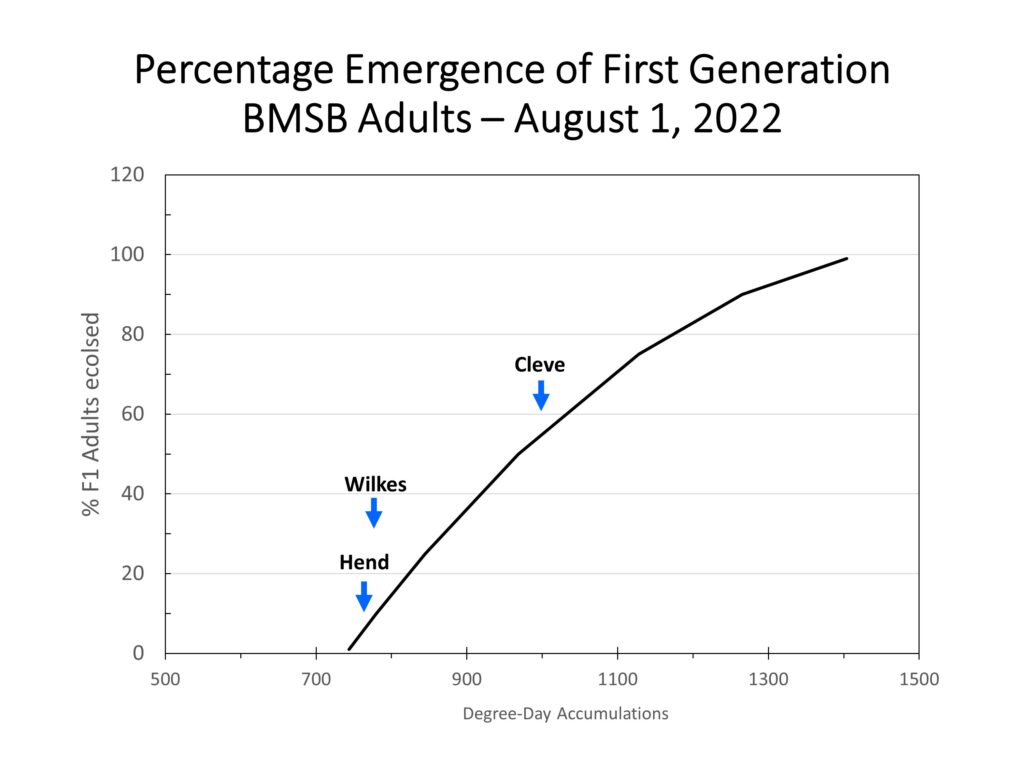WNC Orchard Insect Populations – 2022 archive
go.ncsu.edu/readext?784346
en Español / em Português
El inglés es el idioma de control de esta página. En la medida en que haya algún conflicto entre la traducción al inglés y la traducción, el inglés prevalece.
Al hacer clic en el enlace de traducción se activa un servicio de traducción gratuito para convertir la página al español. Al igual que con cualquier traducción por Internet, la conversión no es sensible al contexto y puede que no traduzca el texto en su significado original. NC State Extension no garantiza la exactitud del texto traducido. Por favor, tenga en cuenta que algunas aplicaciones y/o servicios pueden no funcionar como se espera cuando se traducen.
Português
Inglês é o idioma de controle desta página. Na medida que haja algum conflito entre o texto original em Inglês e a tradução, o Inglês prevalece.
Ao clicar no link de tradução, um serviço gratuito de tradução será ativado para converter a página para o Português. Como em qualquer tradução pela internet, a conversão não é sensivel ao contexto e pode não ocorrer a tradução para o significado orginal. O serviço de Extensão da Carolina do Norte (NC State Extension) não garante a exatidão do texto traduzido. Por favor, observe que algumas funções ou serviços podem não funcionar como esperado após a tradução.
English
English is the controlling language of this page. To the extent there is any conflict between the English text and the translation, English controls.
Clicking on the translation link activates a free translation service to convert the page to Spanish. As with any Internet translation, the conversion is not context-sensitive and may not translate the text to its original meaning. NC State Extension does not guarantee the accuracy of the translated text. Please note that some applications and/or services may not function as expected when translated.
Collapse ▲October 31, 2022
 Most apple insect pest populations have steadily declined over the past few weeks. This is the last time the Trap Capture and Degree Day Tables will be updated in 2022. See you in April 2023!
Most apple insect pest populations have steadily declined over the past few weeks. This is the last time the Trap Capture and Degree Day Tables will be updated in 2022. See you in April 2023!
Learn more about southeastern apple insect pests at the Apple Insect Management page.
2022 Average Weekly Trap Captures
| HENDERSON COUNTY | |||
| Insects per trap | |||
| Oct 17 | Oct 24 | Oct 31 | |
| Codling moth | 0.0 | 0.0 | ended |
| Oriental fruit moth | 6.0 | 0.0 | 0.0 |
| Tufted apple bud moth | 0.0 | 0.0 | ended |
| Redbanded leafroller | 0.0 | 0.0 | ended |
| Obliquebanded leafroller | 1.0 | 2.0 | 0.0 |
| Lesser appleworm | 0.0 | 0.0 | ended |
| Apple maggot (abandoned and research orchards) | 0.0 | 0.0 | ended |
| Brown marmorated stink bug (commercial) | 1.4 | 1.6 | 1.3 |
| Brown marmorated stink bug (unsprayed) | 1.5 | 0.0 | 0.0 |
| Spotted tentiform leafminer | 0.0 | 0.0 | ended |
| Dogwood borer | 0.0 | ended | . |
| Peachtree borer | 0.0 | 0.0 | ended |
| Lesser peachtree borer | 0.0 | 0.0 | ended |
| San Jose scale | ended | . | . |
| Ambrosia beetle (all species) | 0.0 | 0.0 | ended |
*Note that these averages illustrate only the timing of insect emergence and fluctuations in populations, and are not representative of population levels in any given orchard. The only way to have an accurate assessment of an individual orchard’s populations is to set up traps in that orchard.
2022 Accumulated Degree Days
| HENDERSON COUNTY | ||||
| Oct 17 | Oct 24 | Oct 31 | ||
| Codling moth (Biofix: April 22) | 3349 | 3381 | 3420 | |
| Oriental fruit moth (Biofix: April 12) | 4287 | 4334 | 4398 | |
| Tufted apple bud moth (Biofix: April 27) | 4089 | 4136 | 4200 | |
2022 Pest Trends (click to enlarge)
PREVIOUS UPDATES
August 30, 2022
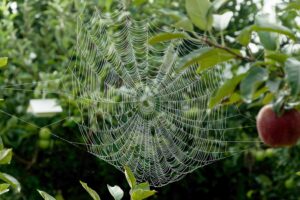 Not much has changed since last week in terms of the key insect pests of concern at this time. First generation brown marmorated stink bug adults continue to emerge, but numbers remain low compared to populations at similar times in past years. Also, apple maggot fly captures have been low in Henderson County, but as mentioned last week this can vary among orchards, particularly in areas where there may be sources of flies near managed orchards or at higher elevations. Although oriental fruit moth pheromone trap captures have increased in the past week at the research station, these are in orchards that are minimally sprayed.
Not much has changed since last week in terms of the key insect pests of concern at this time. First generation brown marmorated stink bug adults continue to emerge, but numbers remain low compared to populations at similar times in past years. Also, apple maggot fly captures have been low in Henderson County, but as mentioned last week this can vary among orchards, particularly in areas where there may be sources of flies near managed orchards or at higher elevations. Although oriental fruit moth pheromone trap captures have increased in the past week at the research station, these are in orchards that are minimally sprayed.
Finally, there have been some reports of late-season European red mite populations showing up in some orchards. Population increases after July are not common, and this probably a response to recent pyrethroid applications made for stink bugs. Trees can generally tolerate higher numbers of mites later in the season, in the range of 10-15 mites per leaf.
Learn more about southeastern apple insect pests at the Apple Insect Management page.
2022 Average Weekly Trap Captures
| HENDERSON COUNTY | |||
| Insects per trap | |||
| Aug 15 | Aug 22 | Aug 29 | |
| Codling moth | 1.0 | 0.0 | 0.0 |
| Oriental fruit moth | 15.0 | 11.0 | 29.5 |
| Tufted apple bud moth | 0.0 | 0.0 | 0.0 |
| Redbanded leafroller | 0.0 | 0.0 | 0.0 |
| Obliquebanded leafroller | 0.0 | 0.0 | 0.0 |
| Lesser appleworm | 0.0 | 0.0 | 0.0 |
| Apple maggot (abandoned and research orchards) | 0.0 | 0.0 | 0.0 |
| Brown marmorated stink bug (commercial) | 1.9 | 1.3 | 2.0 |
| Brown marmorated stink bug (unsprayed) | 4.5 | 4.5 | 9.5 |
| Spotted tentiform leafminer | 0.0 | 0.0 | 0.0 |
| Dogwood borer | 0.0 | 0.0 | 0.0 |
| Peachtree borer | 1.0 | 7.0 | 16.0 |
| Lesser peachtree borer | 9.0 | 7.0 | 13.0 |
| San Jose scale | 0.0 | 0.0 | 70.0 |
| Ambrosia beetle (all species) | 0.0 | 0.0 | 1.0 |
*Note that these averages illustrate only the timing of insect emergence and fluctuations in populations, and are not representative of population levels in any given orchard. The only way to have an accurate assessment of an individual orchard’s populations is to set up traps in that orchard.
2022 Accumulated Degree Days
| HENDERSON COUNTY | ||||
| Aug 15 | Aug 22 | Aug 29 | ||
| Codling moth (Biofix: April 22) | 2358 | 2506 | 2668 | |
| Oriental fruit moth (Biofix: April 12) | 3005 | 3189 | 3385 | |
| Tufted apple bud moth (Biofix: April 27) | 2828 | 2991 | 3188 | |
August 23, 2022
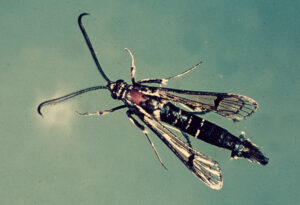 Overall, insect populations are quite low throughout the area. Codling moth and oriental fruit moth trap captures remain low, and there is very little evidence of damaged fruit. Based on model predictions, approximately 50% of first generation brown marmorated stink bug adults have emerged in Henderson and Wilkes Counties, and almost 90% in lower elevations in Cleveland County. However, pheromone trap captures remain surprisingly low. In past years, adult captures were considerably higher at similar DD accumulations. High temperatures during the main egg laying period in mid June and early July may have played a role in suppressing populations.
Overall, insect populations are quite low throughout the area. Codling moth and oriental fruit moth trap captures remain low, and there is very little evidence of damaged fruit. Based on model predictions, approximately 50% of first generation brown marmorated stink bug adults have emerged in Henderson and Wilkes Counties, and almost 90% in lower elevations in Cleveland County. However, pheromone trap captures remain surprisingly low. In past years, adult captures were considerably higher at similar DD accumulations. High temperatures during the main egg laying period in mid June and early July may have played a role in suppressing populations.
Finally, apple maggot populations in Henderson County remain very low. However, populations can vary considerably among locations. In fact, Doug Hundley reported high captures of flies during the past few weeks on red sphere traps in Avery County orchards at elevations of about 3500 ft. It should be noted that orchards located at elevations greater than about 2700 ft have consistently had higher populations than lower elevation orchards.
Peachtree Borer Control
There have been questions regarding how to control peachtree borer now that Lorsban is no longer registered on bearing trees. The only insecticide with PTB on the label is Asana. The labeled rate ranges from 4.8 to 14.5 oz per acre, and applications directed trunk sprays. Two applications at 14-21 days may be necessary.
Learn more about southeastern apple insect pests at the Apple Insect Management page.
2022 Average Weekly Trap Captures
| HENDERSON COUNTY | |||
| Insects per trap | |||
| Aug 8 | Aug 15 | Aug 22 | |
| Codling moth | 0.0 | 1.0 | 0.0 |
| Oriental fruit moth | 9.0 | 15.0 | 11.0 |
| Tufted apple bud moth | 1.0 | 0.0 | 0.0 |
| Redbanded leafroller | 0.0 | 0.0 | 0.0 |
| Obliquebanded leafroller | 0.0 | 0.0 | 0.0 |
| Lesser appleworm | 0.0 | 0.0 | 0.0 |
| Apple maggot (abandoned and research orchards) | 0.0 | 0.0 | 0.0 |
| Brown marmorated stink bug (commercial) | 1.6 | 1.9 | 1.3 |
| Brown marmorated stink bug (unsprayed) | 3.0 | 4.5 | 4.5 |
| Spotted tentiform leafminer | 1.0 | 0.0 | 0.0 |
| Dogwood borer | 0.0 | 0.0 | 0.0 |
| Peachtree borer | 3.0 | 1.0 | 7.0 |
| Lesser peachtree borer | 4.0 | 9.0 | 7.0 |
| San Jose scale | 0.0 | 0.0 | 0.0 |
| Ambrosia beetle (all species) | 0.0 | 0.0 | 0.5 |
*Note that these averages illustrate only the timing of insect emergence and fluctuations in populations, and are not representative of population levels in any given orchard. The only way to have an accurate assessment of an individual orchard’s populations is to set up traps in that orchard.
2022 Accumulated Degree Days
| HENDERSON COUNTY | ||||
| Aug 8 | Aug 15 | Aug 22 | ||
| Codling moth (Biofix: April 22) | 2193 | 2358 | 2506 | |
| Oriental fruit moth (Biofix: April 12) | 2806 | 3005 | 3189 | |
| Tufted apple bud moth (Biofix: April 27) | 2608 | 2828 | 2991 | |
August 16, 2022
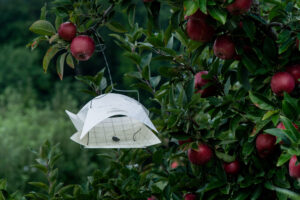 Overall insect pressure is low at this time. While degree-day models indicate that codling moth and oriental fruit moth are in the 3rd and 4th generations, respectively, trap captures remain low throughout the area. This is expected when high levels of control of earlier generations were achieved. Apple maggot trap captures have also been very low, even in our abandoned site.
Overall insect pressure is low at this time. While degree-day models indicate that codling moth and oriental fruit moth are in the 3rd and 4th generations, respectively, trap captures remain low throughout the area. This is expected when high levels of control of earlier generations were achieved. Apple maggot trap captures have also been very low, even in our abandoned site.
Brown marmorated stink bug on later-maturing cultivars remains the key pest of concern, and will be so for about the next month. Based on degree-day model predictions, first generation adult emergence is approximately 40% complete in Henderson and Wilkes counties, and 70% in Cleveland county. However, pheromone trap captures have been lower than expected to date.
Learn more about southeastern apple insect pests at the Apple Insect Management page.
2022 Average Weekly Trap Captures
| HENDERSON COUNTY | |||
| Insects per trap | |||
| Aug 1 | Aug 8 | Aug 15 | |
| Codling moth | 0.0 | 0.0 | 1.0 |
| Oriental fruit moth | 6.0 | 9.0 | 15.0 |
| Tufted apple bud moth | 0.0 | 1.0 | 0.0 |
| Redbanded leafroller | 0.0 | 0.0 | 0.0 |
| Obliquebanded leafroller | 0.0 | 0.0 | 0.0 |
| Lesser appleworm | 0.0 | 0.0 | 0.0 |
| Apple maggot (abandoned and research orchards) | 0.3 | 0.0 | 0.0 |
| Brown marmorated stink bug (commercial) | 1.2 | 1.6 | 1.9 |
| Brown marmorated stink bug (unsprayed) | 6.0 | 3.0 | 4.5 |
| Spotted tentiform leafminer | 0.0 | 1.0 | 0.0 |
| Dogwood borer | 1.0 | 0.0 | 0.0 |
| Peachtree borer | 3.0 | 1.0 | 1.0 |
| Lesser peachtree borer | 4.0 | 9.0 | 6.0 |
| San Jose scale | 0.0 | 0.0 | 2.5 |
| Ambrosia beetle (all species) | 0.0 | 0.0 | 0.0 |
*Note that these averages illustrate only the timing of insect emergence and fluctuations in populations, and are not representative of population levels in any given orchard. The only way to have an accurate assessment of an individual orchard’s populations is to set up traps in that orchard.
2022 Accumulated Degree Days
| HENDERSON COUNTY | ||||
| Aug 1 | Aug 8 | Aug 15 | ||
| Codling moth (Biofix: April 22) | 2020 | 2193 | 2358 | |
| Oriental fruit moth (Biofix: April 12) | 2598 | 2806 | 3005 | |
| Tufted apple bud moth (Biofix: April 27) | 2400 | 2608 | 2828 | |
August 9, 2022
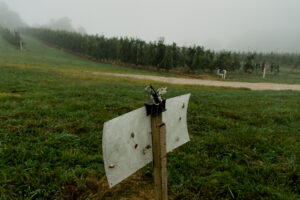 In the vast majority of orchards, the major insect pests of potential threat for the remainder of the season are brown marmorated stink bug and apple maggot. Apple maggot fly captures remain low at our monitoring sites, but abundance and timing of emergence can vary among locations. Emergence of first generation BMSB adults is about 25 to 30% complete in Henderson and Wilkes Counties, respectively, while in lower-elevation orchards such as Cleveland County, it is about 70% complete (see model prediction below).
In the vast majority of orchards, the major insect pests of potential threat for the remainder of the season are brown marmorated stink bug and apple maggot. Apple maggot fly captures remain low at our monitoring sites, but abundance and timing of emergence can vary among locations. Emergence of first generation BMSB adults is about 25 to 30% complete in Henderson and Wilkes Counties, respectively, while in lower-elevation orchards such as Cleveland County, it is about 70% complete (see model prediction below). 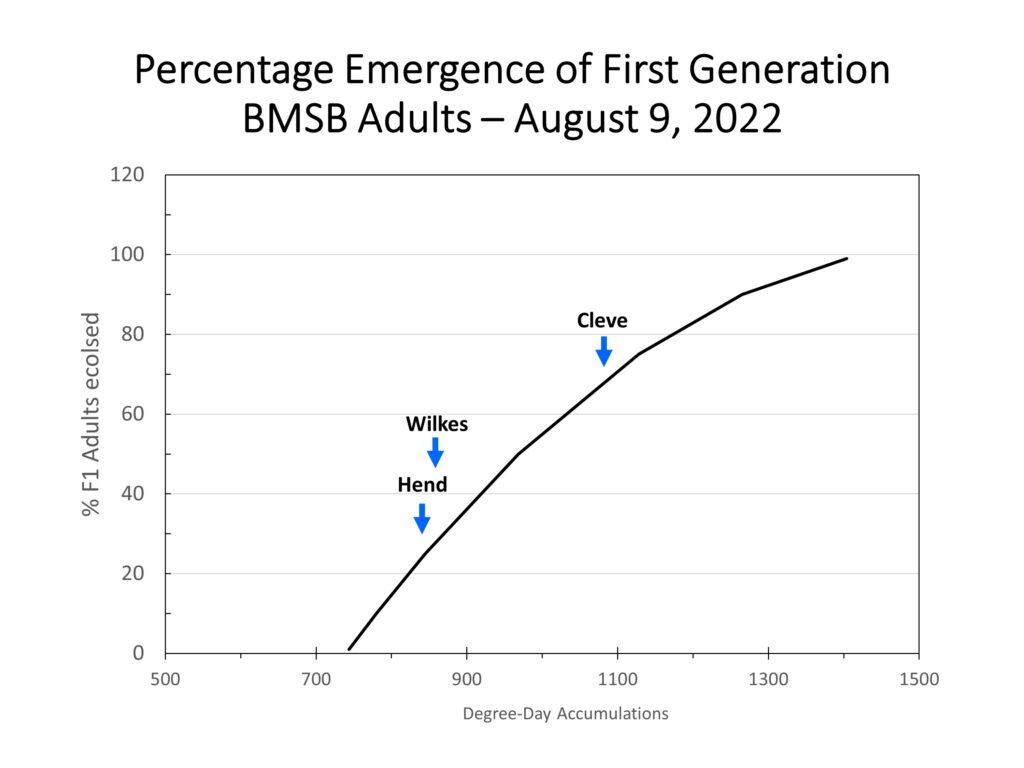
In higher elevations such as Henderson and Wilkes Counties, now is good timing for an insecticide application in orchards with a history of BMSB damage, especially those cultivars with a moderate to high susceptibility (see below). Shown below is a table of relative susceptibility of various apple cultivars to BMSB damage, and the number of insecticide applications typically made to these cultivars. With the exception of Granny Smith apples, which are highly susceptible to damage, insecticides applied at 2-wk intervals up to about 14 days before harvest has worked well. Intervals may need to be shortened to 7 days on Granny Smith when BMSB populations are high.
Learn more about southeastern apple insect pests at the Apple Insect Management page.
2022 Average Weekly Trap Captures
| HENDERSON COUNTY | |||
| Insects per trap | |||
| Jul 25 | Aug 1 | Aug 8 | |
| Codling moth | 0.0 | 0.0 | 0.0 |
| Oriental fruit moth | 9.0 | 6.0 | 9.0 |
| Tufted apple bud moth | 0.0 | 0.0 | 1.0 |
| Redbanded leafroller | 1.0 | 0.0 | 0.0 |
| Obliquebanded leafroller | 1.0 | 0.0 | 0.0 |
| Lesser appleworm | 1.0 | 0.0 | 0.0 |
| Apple maggot (abandoned and research orchards) | 0.0 | 0.3 | 0.0 |
| Brown marmorated stink bug (commercial) | 1.5 | 1.2 | 1.6 |
| Brown marmorated stink bug (unsprayed) | 13.5 | 6.0 | 3.0 |
| Spotted tentiform leafminer | 0.0 | 0.0 | 1.0 |
| Dogwood borer | 1.0 | 1.0 | 0.0 |
| Peachtree borer | 2.0 | 3.0 | 1.0 |
| Lesser peachtree borer | 7.0 | 4.0 | 9.0 |
| San Jose scale | 0.0 | 0.0 | 0.0 |
| Ambrosia beetle (all species) | 0.0 | 0.0 | 0.0 |
*Note that these averages illustrate only the timing of insect emergence and fluctuations in populations, and are not representative of population levels in any given orchard. The only way to have an accurate assessment of an individual orchard’s populations is to set up traps in that orchard.
2022 Accumulated Degree Days
| HENDERSON COUNTY | ||||
| Jul 25 | Aug 1 | Aug 8 | ||
| Codling moth (Biofix: April 22) | 1821 | 2020 | 2193 | |
| Oriental fruit moth (Biofix: April 12) | 2371 | 2598 | 2806 | |
| Tufted apple bud moth (Biofix: April 27) | 2173 | 2400 | 2608 | |
August 2, 2022
 First generation brown marmorated stink bug emergence is beginning in Henderson and Wilkes Counties and other locations of similar elevation. Hence, pheromone trap captures should begin to increase next week; trap captures shown in this week’s figures represent last week’s captures. The potential for damage by BMSB will increase over the next few weeks, particularly on cultivars most susceptible to damage. See model predictions below for BMSB adult emergence and the table for insecticides recommended for control.
First generation brown marmorated stink bug emergence is beginning in Henderson and Wilkes Counties and other locations of similar elevation. Hence, pheromone trap captures should begin to increase next week; trap captures shown in this week’s figures represent last week’s captures. The potential for damage by BMSB will increase over the next few weeks, particularly on cultivars most susceptible to damage. See model predictions below for BMSB adult emergence and the table for insecticides recommended for control.
It is emphasized that BMSB rarely causes damage to early maturing cultivars such as Ginger Gold and Gala, so targeting these varieties with an insecticide for BMSB is probably not necessary. Those cultivars harvested in September are more susceptible, with Granny Smith, Pink Lady, Fuji, and finally Romes most susceptible to injury.
Insecticides recommended for brown marmorated stink bug control on apples |
||||
| Common name | Brand name | Pre-harvest interval (d) |
Rate/Acre (fl oz) |
Maximum fl oz/season |
| Pyrethroids | ||||
| Bifenthrin | Brigade 2EC, Fanfare 2EC | 14 | 9.6 | 28.8 |
| Beta-cyfluthrin | Tombstone 2EC | 7 | 2.4 | 2.8 |
| Cyfluthrin | Baythroid 1EC | 7 | 2.8 | 2.8 |
| Fenpropathrin | Danitol 2.4EC | 14 | 21.3 | 42.6 |
| Gamma- cyhalothrin | Proaxis 0.5EC | 14 | 5.12 | 20.48 |
| Lambda-cyhalothrin | Warrior II 2.08SC | 21 | 2.56 | 10.24 |
| Zeta-cypermethrin | Mustang Maxx 0.8EC | 14 | 4.0 | 24 |
| Neonicotinoids | ||||
| Chlothianidin | Belay 2.13F | 7 | 6 | 12 |
| Premixes | ||||
|
Lambda-cyhalothrin + chlorantraniliprole |
Besiege | 21 | 12 | 31 |
Codling moth, oriental fruit moth, and apple maggot
Second generation codling moth is either complete or nearing completion throughout the region. While there is sufficient time for a partial third generation, the potential for damage from this point forward is very low. Third and fourth generation OFM populations begin to overlap at this point in the season and models become less useful. Pheromone trap captures are the best tool for determining the need for insecticide sprays, but populations are generally low in commercial orchards and insecticides applied for BMSB will further suppress OFM.
Finally, the first apple maggot of the year was captured at our abandoned site this past week. While it is not an issue at this time, expect numbers to increase over the next few weeks.
Learn more about southeastern apple insect pests at the Apple Insect Management page.
2022 Average Weekly Trap Captures
| HENDERSON COUNTY | |||
| Insects per trap | |||
| Jul 18 | Jul 25 | Aug 1 | |
| Codling moth | 2.0 | 0.0 | 0.0 |
| Oriental fruit moth | 14.5 | 9.0 | 6.0 |
| Tufted apple bud moth | 0.0 | 0.0 | 0.0 |
| Redbanded leafroller | 0.0 | 1.0 | 0.0 |
| Obliquebanded leafroller | 1.0 | 1.0 | 0.0 |
| Lesser appleworm | 2.0 | 1.0 | 0.0 |
| Apple maggot (abandoned and research orchards) | 0.0 | 0.0 | 0.3 |
| Brown marmorated stink bug (commercial) | 1.3 | 1.5 | 1.2 |
| Brown marmorated stink bug (unsprayed) | 2.0 | 13.5 | 6.0 |
| Spotted tentiform leafminer | 1.0 | 0.0 | 0.0 |
| Dogwood borer | 0.0 | 1.0 | 1.0 |
| Peachtree borer | 2.0 | 2.0 | 3.0 |
| Lesser peachtree borer | 3.0 | 7.0 | 4.0 |
| San Jose scale | 5.0 | 0.0 | 0.0 |
| Ambrosia beetle (all species) | 0.3 | 0.0 | 0.0 |
*Note that these averages illustrate only the timing of insect emergence and fluctuations in populations, and are not representative of population levels in any given orchard. The only way to have an accurate assessment of an individual orchard’s populations is to set up traps in that orchard.
2022 Accumulated Degree Days
| HENDERSON COUNTY | ||||
| Jul 18 | Jul 25 | Aug 1 | ||
| Codling moth (Biofix: April 22) | 1643 | 1821 | 2020 | |
| Oriental fruit moth (Biofix: April 12) | 2163 | 2371 | 2598 | |
| Tufted apple bud moth (Biofix: April 27) | 1965 | 2173 | 2400 | |
July 26, 2022
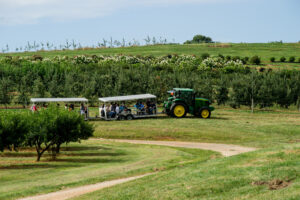 We are approaching the end of second generation codling moth in Henderson County and similar elevations, with egg hatch about 65% complete. Unless there is evidence of problems to date (i.e., some fruit damage or high pheromone trap captures), there is a low potential for damage from this point forward. In Cleveland County and similarly low elevations, the second generation has completed development. While third generation activity is not uncommon in lower elevations, the need for insecticidal control is rare unless population pressure has been high, in which case there would be some evidence of damaged fruit at this time.
We are approaching the end of second generation codling moth in Henderson County and similar elevations, with egg hatch about 65% complete. Unless there is evidence of problems to date (i.e., some fruit damage or high pheromone trap captures), there is a low potential for damage from this point forward. In Cleveland County and similarly low elevations, the second generation has completed development. While third generation activity is not uncommon in lower elevations, the need for insecticidal control is rare unless population pressure has been high, in which case there would be some evidence of damaged fruit at this time.
The only other insect of potential concern at this time is brown marmorated stink bug, primarily in lower elevation orchards. Model predictions shown below indicate that approximate emergence of first generation adults is almost 40% complete in lower elevations (Cleveland Co.), but has not yet begun in higher elevations such as Henderson and Wilkes Counties. If a pyrethroid insecticide recommended for BMSB has not been applied to susceptible cultivars in lower elevation orchards, one should be considered at this time. Insecticidal control should not be necessary in Wilkes or Henderson County for another couple of weeks, the exception being Granny Smith apples (as discussed last week).
We have still not captured apple maggot flies at either the Mills River research station or at our abandoned site in Henderson County. In recent years apple maggot activity has not begun until the second or third week of August.
2022 Apple Field Day
Finally, remember that Apple Field Day will be held at 4:00 p.m. this Thursday, July 28, at the Mountain Horticultural Crops Research and Extension Center in Mills River. There are many good presentations scheduled and admission is free!
Learn more about southeastern apple insect pests at the Apple Insect Management page.
2022 Average Weekly Trap Captures
| HENDERSON COUNTY | |||
| Insects per trap | |||
| Jul 11 | Jul 18 | Jul 25 | |
| Codling moth | 0.5 | 2.0 | 0.0 |
| Oriental fruit moth | 10.0 | 14.5 | 9.0 |
| Tufted apple bud moth | 0.0 | 0.0 | 0.0 |
| Redbanded leafroller | 0.0 | 0.0 | 1.0 |
| Obliquebanded leafroller | 0.0 | 1.0 | 1.0 |
| Lesser appleworm | 0.0 | 2.0 | 1.0 |
| Apple maggot (abandoned and research orchards) | 0.0 | 0.0 | 0.0 |
| Brown marmorated stink bug (commercial) | 1.5 | 1.3 | 1.5 |
| Brown marmorated stink bug (unsprayed) | 1.0 | 2.0 | 13.5 |
| Spotted tentiform leafminer | 0.0 | 1.0 | 0.0 |
| Dogwood borer | 1.0 | 0.0 | 1.0 |
| Peachtree borer | 20.0 | 2.0 | 2.0 |
| Lesser peachtree borer | 45.0 | 3.0 | 7.0 |
| San Jose scale | 12.5 | 5.0 | 0.0 |
| Ambrosia beetle (all species) | 0.5 | 0.3 | 0.0 |
*Note that these averages illustrate only the timing of insect emergence and fluctuations in populations, and are not representative of population levels in any given orchard. The only way to have an accurate assessment of an individual orchard’s populations is to set up traps in that orchard.
2022 Accumulated Degree Days
| HENDERSON COUNTY | ||||
| Jul 11 | Jul 18 | Jul 25 | ||
| Codling moth (Biofix: April 22) | 1478 | 1643 | 1821 | |
| Oriental fruit moth (Biofix: April 12) | 1963 | 2163 | 2371 | |
| Tufted apple bud moth (Biofix: April 27) | 1766 | 1965 | 2173 | |
July 19, 2022
 As has been the trend for season, codling moth populations remain low throughout the region, with about 31% egg hatch of the second generation complete in Henderson County, and essentially completed in Cleveland County. If codling moth has not been an issue in your orchard to date, it is highly unlikely to become so the remainder of the year. While oriental fruit moth (OFM) has been spotty, populations do tend to increase during August and September. However, in those regions where pyrethroids have been targeted on brown marmorated stink bug (BMSB), OFM will also be controlled.
As has been the trend for season, codling moth populations remain low throughout the region, with about 31% egg hatch of the second generation complete in Henderson County, and essentially completed in Cleveland County. If codling moth has not been an issue in your orchard to date, it is highly unlikely to become so the remainder of the year. While oriental fruit moth (OFM) has been spotty, populations do tend to increase during August and September. However, in those regions where pyrethroids have been targeted on brown marmorated stink bug (BMSB), OFM will also be controlled.
First generation BMSB adult emergence has begun in Cleveland County and is about 20% complete, so now is an important time for protection of susceptible cultivars. While adult emergence has not yet begun in higher elevations such as Henderson, Wilkes and Haywood counties, recent studies have shown that ‘Granny Smith’ apples become highly attractive to surviving overwintered adults, and an insecticide application before July 30 is likely warranted in locations where populations are high or where there is a history of BMSB damage.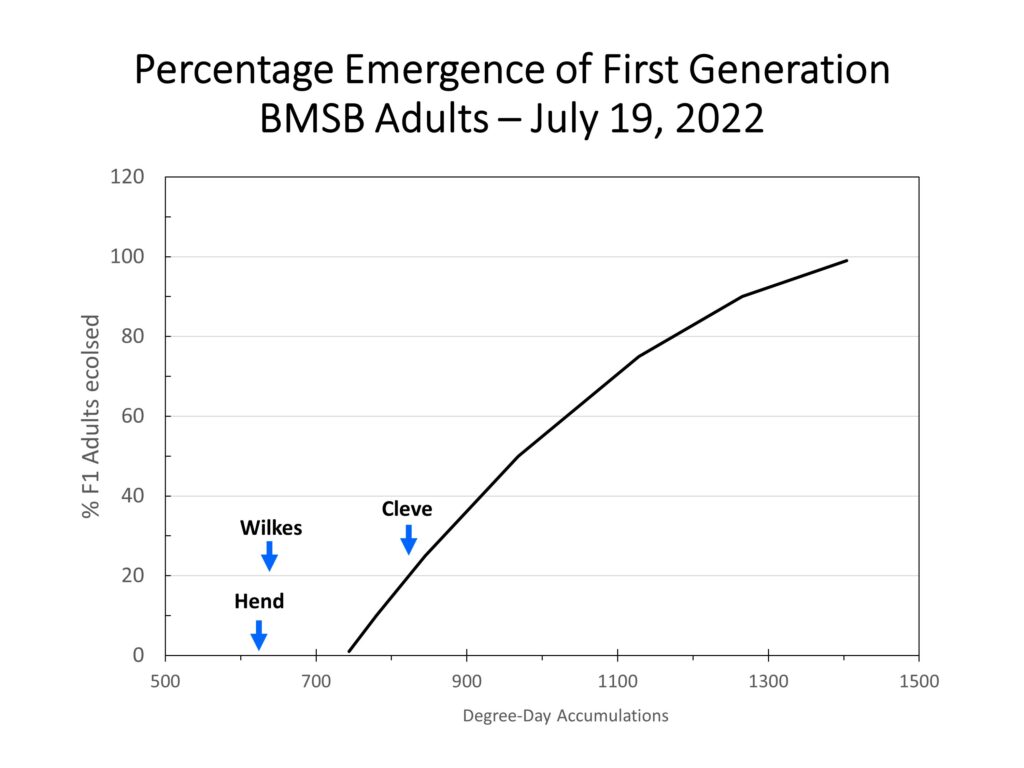
2022 Apple Field Day
Remember that Apple Field Day will occur on July 28 at the Mountain Horticultural Crops Research and Extension Center in Mills River. There are many good presentations scheduled and admission is free!
Learn more about southeastern apple insect pests at the Apple Insect Management page.
2022 Average Weekly Trap Captures
| HENDERSON COUNTY | |||
| Insects per trap | |||
| Jul 5 | Jul 11 | Jul 18 | |
| Codling moth | 0.0 | 0.5 | 2.0 |
| Oriental fruit moth | 17.0 | 10.0 | 14.5 |
| Tufted apple bud moth | 0.0 | 0.0 | 0.0 |
| Redbanded leafroller | 0.0 | 0.0 | 0.0 |
| Obliquebanded leafroller | 0.0 | 0.0 | 1.0 |
| Lesser appleworm | 0.0 | 0.0 | 2.0 |
| Apple maggot (abandoned and research orchards) | 0.0 | 0.0 | 0.0 |
| Brown marmorated stink bug (commercial) | 1.3 | 1.5 | 1.3 |
| Brown marmorated stink bug (unsprayed) | 2.5 | 1.0 | 2.0 |
| Spotted tentiform leafminer | 0.0 | 0.0 | 1.0 |
| Dogwood borer | 1.0 | 1.0 | 0.0 |
| Peachtree borer | 12.0 | 20.0 | 2.0 |
| Lesser peachtree borer | 41.0 | 45.0 | 3.0 |
| San Jose scale | 22.5 | 12.5 | 5.0 |
| Ambrosia beetle (all species) | 1.0 | 0.5 | 0.3 |
*Note that these averages illustrate only the timing of insect emergence and fluctuations in populations, and are not representative of population levels in any given orchard. The only way to have an accurate assessment of an individual orchard’s populations is to set up traps in that orchard.
2022 Accumulated Degree Days
| HENDERSON COUNTY | ||||
| Jul 5 | Jul 11 | Jul 18 | ||
| Codling moth (Biofix: April 22) | 1320 | 1478 | 1643 | |
| Oriental fruit moth (Biofix: April 12) | 1775 | 1963 | 2163 | |
| Tufted apple bud moth (Biofix: April 27) | 1577 | 1766 | 1965 | |
July 12, 2022
 Codling moth and oriental fruit moth populations remain relatively low throughout the region, but they both remain a potential threat based on their stage of development. In Henderson County, second generation codling moth is in the early stages of egg laying, and will continue to lay over the next several weeks. Second generation OFM is in the early stages of emergence. In lower elevation Cleveland County, both second generation codling moth and third generation OFM is in the midst of egg laying (about 60% complete). While a single insecticide application targeting these populations is sufficient in most orchards where populations are low, the use of pheromone traps is the only way to monitor population density and confidently make a decision to not spray.
Codling moth and oriental fruit moth populations remain relatively low throughout the region, but they both remain a potential threat based on their stage of development. In Henderson County, second generation codling moth is in the early stages of egg laying, and will continue to lay over the next several weeks. Second generation OFM is in the early stages of emergence. In lower elevation Cleveland County, both second generation codling moth and third generation OFM is in the midst of egg laying (about 60% complete). While a single insecticide application targeting these populations is sufficient in most orchards where populations are low, the use of pheromone traps is the only way to monitor population density and confidently make a decision to not spray.
First generation brown marmorated stink bug (BMSB) adults are on the cusp of emergence in Cleveland County (see figure below), so expect adult numbers to be increasing over the next several weeks. Adult emergence is still several weeks away in higher elevation orchards in Henderson, Haywood and Wilkes Counties. Most pyrethroid insecticides provide good control of BMSB. Pyrethroids will also do an excellent job of controlling OFM populations.
Bifenthrin Now Registered on Apples and Peaches
For the past 10 years or so, bifenthrin has been allowed on apples and peaches via a Section 18 label. Last November the EPA approved a full label (Section 3) for use on pome and stone fruits. Products available for use include Brigade 2EC and WSB, Fanfare 2EC and 2SC, and the premix Hero (contains bifenthrin and zeta-cypermethrin). Maximum use after petal fall cannot exceed 3 applications per year and a total of 0.45 lbs AI per acre.
2022 Apple Field Day
Finally, remember that Apple Field Day will occur on July 28 at the Mountain Horticultural Crops Research and Extension Center in Mills River. There are many good presentations scheduled and admission is free!
Learn more about southeastern apple insect pests at the Apple Insect Management page.
2022 Average Weekly Trap Captures
| HENDERSON COUNTY | |||
| Insects per trap | |||
| Jun 27 | Jul 5 | Jul 11 | |
| Codling moth | 0.0 | 0.0 | 0.5 |
| Oriental fruit moth | 20.5 | 17.0 | 10.0 |
| Tufted apple bud moth | 0.0 | 0.0 | 0.0 |
| Redbanded leafroller | 0.0 | 0.0 | 0.0 |
| Obliquebanded leafroller | 3.0 | 0.0 | 0.0 |
| Lesser appleworm | 0.0 | 0.0 | 0.0 |
| Apple maggot (abandoned and research orchards) | 0.0 | 0.0 | 0.0 |
| Brown marmorated stink bug (commercial) | 3.1 | 1.3 | 1.5 |
| Brown marmorated stink bug (unsprayed) | 2.5 | 2.5 | 1.0 |
| Spotted tentiform leafminer | 0.0 | 0.0 | 0.0 |
| Dogwood borer | 1.0 | 1.0 | 0.0 |
| Peachtree borer | 11.0 | 12.0 | 20.0 |
| Lesser peachtree borer | 27.0 | 41.0 | 45.0 |
| San Jose scale | 27.5 | 22.5 | 12.5 |
| Ambrosia beetle (all species) | 3.0 | 1.0 | 0.5 |
*Note that these averages illustrate only the timing of insect emergence and fluctuations in populations, and are not representative of population levels in any given orchard. The only way to have an accurate assessment of an individual orchard’s populations is to set up traps in that orchard.
2022 Accumulated Degree Days
| HENDERSON COUNTY | ||||
| Jun 27 | Jul 5 | Jul 11 | ||
| Codling moth (Biofix: April 22) | 1126 | 1320 | 1478 | |
| Oriental fruit moth (Biofix: April 12) | 1541 | 1775 | 1963 | |
| Tufted apple bud moth (Biofix: April 27) | 1343 | 1577 | 1766 | |
July 5, 2022
 Second generation codling moth remains a potential threat throughout the region. Degree-day accumulations range from 1320 in Henderson County to about 1660 in Cleveland County. Under low population densities when a single insecticide application generally provides the necessary level of control, the optimum timing is between 1400 and 1450 DD after biofix. Hence, in Henderson County and similar elevations, that timing is this week – 1400 DD is predicted to occur on Friday. In lower elevation sites, an application targeting codling moth should be considered if one has not been made in the past week. Insecticidal control of second generation is generally not necessary in orchards using mating disruption, but pheromone trap captures should be used to verify low densities. Moth captures should remain below an average of 3 cumulative moths/trap in mating disruption orchards, otherwise an insecticide application may be warranted.
Second generation codling moth remains a potential threat throughout the region. Degree-day accumulations range from 1320 in Henderson County to about 1660 in Cleveland County. Under low population densities when a single insecticide application generally provides the necessary level of control, the optimum timing is between 1400 and 1450 DD after biofix. Hence, in Henderson County and similar elevations, that timing is this week – 1400 DD is predicted to occur on Friday. In lower elevation sites, an application targeting codling moth should be considered if one has not been made in the past week. Insecticidal control of second generation is generally not necessary in orchards using mating disruption, but pheromone trap captures should be used to verify low densities. Moth captures should remain below an average of 3 cumulative moths/trap in mating disruption orchards, otherwise an insecticide application may be warranted.
First Generation BMSB Adult Emergence
In lower elevation orchards, we are approaching the initial emergence of the first generation of brown marmorated stink bug (BMSB) emergence. This adult generation is the major cause of stink bug damage to mid- and late-maturing apple cultivars. Emergence begins at about 750 DD (°C) from 4 April, which is predicted to occur in about 7 days in Cleveland County and similar elevations. It will be almost another 3 weeks before emergence begins in Henderson and Wilkes Counties. The solid curve in the figure below depicts percent emergence of first generation adults, and the arrows show cumulative DDs in Henderson, Wilkes and Cleveland Counties.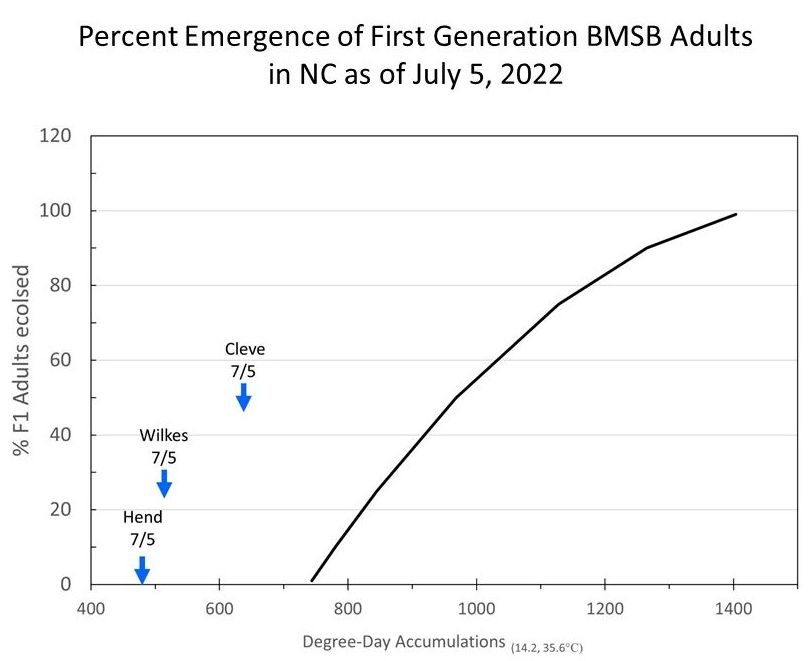
Other Pests
Populations of secondary pests including aphids, leafhoppers, mites and Japanese beetles have been very spotty this year. With the frequency of rain increasing in many areas, Japanese beetle numbers may be increasing. At the research station in Mills River, second generation adults of San Jose scale are in the second week of emergence. Control at this time of the year is generally not necessary when populations were suppressed early in the year. Finally, so far we have not seen nor been made aware of any apple maggot activity.
Learn more about southeastern apple insect pests at the Apple Insect Management page.
2022 Average Weekly Trap Captures
| HENDERSON COUNTY | |||
| Insects per trap | |||
| Jun 20 | Jun 27 | Jul 5 | |
| Codling moth | 0.0 | 0.0 | 0.0 |
| Oriental fruit moth | 19.0 | 20.5 | 17.0 |
| Tufted apple bud moth | 0.0 | 0.0 | 0.0 |
| Redbanded leafroller | 0.0 | 0.0 | 0.0 |
| Obliquebanded leafroller | 3.0 | 3.0 | 0.0 |
| Lesser appleworm | 0.0 | 0.0 | 0.0 |
| Apple maggot (abandoned and research orchards) | 0.0 | 0.0 | 0.0 |
| Brown marmorated stink bug (commercial) | – | 3.1 | 1.3 |
| Brown marmorated stink bug (unsprayed) | 3.0 | 2.5 | 2.5 |
| Spotted tentiform leafminer | 0.0 | 0.0 | 0.0 |
| Dogwood borer | 0.0 | 1.0 | 1.0 |
| Peachtree borer | 5.0 | 11.0 | 12.0 |
| Lesser peachtree borer | 30.0 | 27.0 | 41.0 |
| San Jose scale | 0.0 | 27.5 | 22.5 |
| Ambrosia beetle (all species) | 3.0 | 3.0 | 1.0 |
*Note that these averages illustrate only the timing of insect emergence and fluctuations in populations, and are not representative of population levels in any given orchard. The only way to have an accurate assessment of an individual orchard’s populations is to set up traps in that orchard.
2022 Accumulated Degree Days
| HENDERSON COUNTY | ||||
| Jun 20 | Jun 27 | Jul 5 | ||
| Codling moth (Biofix: April 22) | 974 | 1126 | 1320 | |
| Oriental fruit moth (Biofix: April 12) | 1359 | 1541 | 1775 | |
| Tufted apple bud moth (Biofix: April 27) | 1161 | 1343 | 1577 | |
June 28, 2022
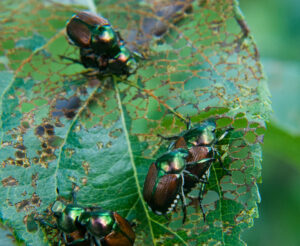 There are several groups of insect pests that are potential threats to apples, but with a few exceptions overall insect pressure remains relatively low across the region. Depending on location, codling moth and oriental fruit moth can be a concern. Among indirect pests, aphids, leafhoppers, mites and Japanese beetles are all active at this time.
There are several groups of insect pests that are potential threats to apples, but with a few exceptions overall insect pressure remains relatively low across the region. Depending on location, codling moth and oriental fruit moth can be a concern. Among indirect pests, aphids, leafhoppers, mites and Japanese beetles are all active at this time.
Codling moth degree day accumulations range from 1127 DD to 1437 DD in Henderson and Cleveland Counties, respectively. In Cleveland County and similar elevations, second generation egg hatch is about 10% complete and will be about 30% complete next week, so now is an important time to monitor trap captures and apply insecticides if warranted. In Henderson County, it is expected to be another 7 to 10 days before flight activity picks up. Chemical control is necessary in orchards with pheromone trap captures increasing above about 5 moths/trap/week. Insecticidal control is usually not necessary in orchards using mating disruption. Overall, codling moth populations have been low throughout the region this year.
Oriental fruit moth is in the midst of second generation flight in Henderson County, and while overall populations have been low, moth activity has been relatively high in a couple of orchards. So again, pheromone traps are valuable tools for assessing the need for chemical control.
Green aphid and potato leafhopper populations have been quite low this year, even in orchards not sprayed with aphicides in recent weeks. Japanese beetle populations have increased considerably over the past 10-14 days. Drought conditions are known to reduce survival of Japanese beetle larvae in the soil, so with increasing chances of rainfall over the next week or so, expect to see higher numbers. Populations should be closely monitored on young trees where new shoot growth is most important.
Learn more about southeastern apple insect pests at the Apple Insect Management page.
2022 Average Weekly Trap Captures
| HENDERSON COUNTY | |||
| Insects per trap | |||
| Jun 13 | Jun 20 | Jun 27 | |
| Codling moth | 0.0 | 0.0 | 0.0 |
| Oriental fruit moth | 23.0 | 19.0 | 20.5 |
| Tufted apple bud moth | 1.0 | 0.0 | 0.0 |
| Redbanded leafroller | 0.0 | 0.0 | 0.0 |
| Obliquebanded leafroller | 7.0 | 3.0 | 3.0 |
| Lesser appleworm | 0.0 | 0.0 | 0.0 |
| Apple maggot (abandoned and research orchards) | 0.0 | 0.0 | 0.0 |
| Brown marmorated stink bug (commercial) | – | – | 3.1 |
| Brown marmorated stink bug (unsprayed) | 1.5 | 3.0 | 2.5 |
| Spotted tentiform leafminer | 4.0 | 0.0 | 0.0 |
| Dogwood borer | 1.0 | 1.0 | 1.0 |
| Peachtree borer | 5.0 | 5.0 | 11.0 |
| Lesser peachtree borer | 14.0 | 30.0 | 27.0 |
| San Jose scale | 0.0 | 0.0 | 27.5 |
| Ambrosia beetle (all species) | 0.8 | 3.0 | 3.0 |
*Note that these averages illustrate only the timing of insect emergence and fluctuations in populations, and are not representative of population levels in any given orchard. The only way to have an accurate assessment of an individual orchard’s populations is to set up traps in that orchard.
2022 Accumulated Degree Days
| HENDERSON COUNTY | ||||
| Jun 13 | Jun 20 | Jun 27 | ||
| Codling moth (Biofix: April 22) | 800 | 974 | 1126 | |
| Oriental fruit moth (Biofix: April 12) | 1162 | 1359 | 1541 | |
| Tufted apple bud moth (Biofix: April 27) | 964 | 1161 | 1343 | |
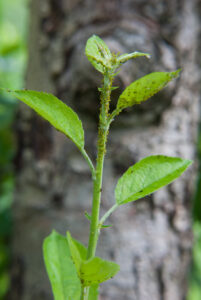 June 21, 2022
June 21, 2022
Codling Moth: Second generation codling moth is beginning to emerge in Cleveland County and similar elevations (about 800 to 1000 ft), while at higher elevations we remain between generations. Insecticide use at this time should not be necessary in the majority of orchards in Henderson or Wilkes Counties.
Codling moth DD accumulations in Cleveland County are about 1260. While pheromone trap captures are the best indicator of activity, in orchards with low populations (i.e., no damage by first generation larvae and low pheromone trap captures), a single application timed at about 1400 DD is often sufficient for second-generation control. When choosing an insecticide to use for second generation codling moth, remember to use a product that was not used during first generation flight. In orchards using mating disruption, it is highly unlikely that insecticides are necessary for second generation codling moth.
Oriental Fruit Moth: We are in the midst of second generation flight in higher elevation orchards (Henderson and Wilkes), while second generation flight is essentially complete in lower elevation orchards. Generally second generation OFM poses little threat to apples, but trap captures have been high in several orchards this season, especially those that have not used mating disruption for several years.
Secondary Pests (Mites, Aphids, Leafhoppers): With hot temperatures returning, European red mite obviously remains a threat in many orchards. To date, aphid and leafhopper populations have been very low on apples, but keep an eye out for them as they do remain a threat.
Learn more about southeastern apple insect pests at the Apple Insect Management page.
2022 Average Weekly Trap Captures
| HENDERSON COUNTY | |||
| Insects per trap | |||
| Jun 6 | Jun 13 | Jun 20 | |
| Codling moth | 0.0 | 0.0 | 0.0 |
| Oriental fruit moth | 4.5 | 23.0 | 19.0 |
| Tufted apple bud moth | 3.0 | 1.0 | 0.0 |
| Redbanded leafroller | 0.0 | 0.0 | 0.0 |
| Obliquebanded leafroller | 1.0 | 7.0 | 3.0 |
| Lesser appleworm | 0.0 | 0.0 | 0.0 |
| Apple maggot (abandoned and research orchards) | set | 0.0 | 0.0 |
| Brown marmorated stink bug (commercial) | – | – | – |
| Brown marmorated stink bug (unsprayed) | 2.5 | 1.5 | 3.0 |
| Spotted tentiform leafminer | 0.0 | 4.0 | 0.0 |
| Dogwood borer | 54.0 | 1.0 | 1.0 |
| Peachtree borer | 2.0 | 5.0 | 5.0 |
| Lesser peachtree borer | 9.0 | 14.0 | 30.0 |
| San Jose scale | 0.0 | 0.0 | 0.0 |
| Ambrosia beetle (all species) | 3.0 | 0.8 | 3.0 |
*Note that these averages illustrate only the timing of insect emergence and fluctuations in populations, and are not representative of population levels in any given orchard. The only way to have an accurate assessment of an individual orchard’s populations is to set up traps in that orchard.
2022 Accumulated Degree Days
| HENDERSON COUNTY | ||||
| Jun 6 | Jun 13 | Jun 20 | ||
| Codling moth (Biofix: April 22) | 666 | 800 | 974 | |
| Oriental fruit moth (Biofix: April 12) | 994 | 1162 | 1359 | |
| Tufted apple bud moth (Biofix: April 27) | 796 | 964 | 1161 | |
June 14, 2022
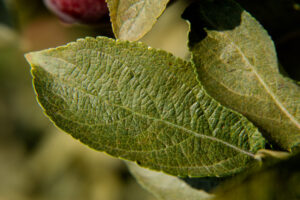 Lepidopteran Pests (codling moth, tufted apple bud moth, oriental fruit moth). With first generation codling moth flight nearing completion in Henderson County, and between generations in Cleveland County, codling moth should not be a concern throughout the region for several weeks. Also, if an insecticide recommended for tufted apple bud moth has not been applied since the beginning June, the window for obtaining season-long control will remain open for another week or so.
Lepidopteran Pests (codling moth, tufted apple bud moth, oriental fruit moth). With first generation codling moth flight nearing completion in Henderson County, and between generations in Cleveland County, codling moth should not be a concern throughout the region for several weeks. Also, if an insecticide recommended for tufted apple bud moth has not been applied since the beginning June, the window for obtaining season-long control will remain open for another week or so.
Second generation oriental fruit moth flight is underway throughout the region. Generally this generation is of little concern if good control was achieved against the first generation, which is the case based on the absence of damage in commercial orchards. However, OFM captures in pheromone traps have been somewhat higher than normal this season, so it is worth keeping an eye on this insect over the next few weeks. Unfortunately pheromone trap captures are not always a good measure of the threat of damage for this insect, but moth captures of more than 10 to 15 per week may warrant insecticidal control.
Secondary Pests (mites, aphids and leafhoppers). With a hot forecast, sampling for European red mite should be a priority at this time. While touring several commercial orchards last week, low populations of European red mite were observed in most locations. Under these hot conditions populations can increase quickly. A threshold of 5 to 10 mites per leaflet is recommended during June. Aphids and leafhoppers remain low, but populations should be increasing soon.
San Jose Scale (SJS). In addition to scale showing up on fruit in Polk and Cleveland County in the past two weeks, it has also appeared in several orchards in Henderson County in the last week. In those orchards with scale showing up, several insecticide options exist, including Assail (6-8 oz), Diazinon 50W (2-4 lbs/A), Centaur (34/5 oz/A), and Movento (6 to 9 oz/A). Senstar (18 fl oz/A) is a premix labeled for scale that includes the active ingredients in Esteem (pyriproxyfen) and Movento (spirotetramat). If orchards were previously treated with Esteem or Movento, Senstar is not recommended.
Learn more about southeastern apple insect pests at the Apple Insect Management page.
2022 Average Weekly Trap Captures
| HENDERSON COUNTY | |||
| Insects per trap | |||
| May 31 | Jun 6 | Jun 13 | |
| Codling moth | 0.5 | 0.0 | 0.0 |
| Oriental fruit moth | 3.5 | 4.5 | 23.0 |
| Tufted apple bud moth | 24.0 | 3.0 | 1.0 |
| Redbanded leafroller | 0.0 | 0.0 | 0.0 |
| Obliquebanded leafroller | 4.0 | 1.0 | 7.0 |
| Lesser appleworm | 0.0 | 0.0 | 0.0 |
| Apple maggot (abandoned and research orchards) | – | set | 0.0 |
| Brown marmorated stink bug (commercial) | – | – | – |
| Brown marmorated stink bug (unsprayed) | 0.5 | 2.5 | 1.5 |
| Spotted tentiform leafminer | 0.0 | 0.0 | 4.0 |
| Dogwood borer | 82.0 | 54.0 | 1.0 |
| Peachtree borer | 2.0 | 5.0 | 6.0 |
| Lesser peachtree borer | 9.0 | 14.0 | 50.0 |
| San Jose scale | 0.0 | 0.0 | 0.0 |
| Ambrosia beetle (all species) | 3.0 | 0.8 | 2.0 |
*Note that these averages illustrate only the timing of insect emergence and fluctuations in populations, and are not representative of population levels in any given orchard. The only way to have an accurate assessment of an individual orchard’s populations is to set up traps in that orchard.
2022 Accumulated Degree Days
| HENDERSON COUNTY | ||||
| May 31 | Jun 6 | Jun 13 | ||
| Codling moth (Biofix: April 22) | 555 | 666 | 800 | |
| Oriental fruit moth (Biofix: April 12) | 852 | 994 | 1162 | |
| Tufted apple bud moth (Biofix: April 27) | 655 | 796 | 964 | |
June 7, 2022
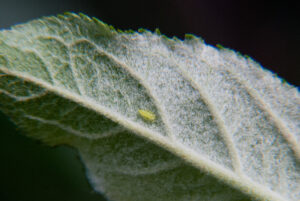 Codling Moth: In Henderson County and similar elevations, approximately 680 DD have accumulated, which is equivalent to about 50% egg hatch of the first generation. Hence, codling moth remains a potential threat and will be for another 10 days or so. At lower elevations such as Cleveland County, approximately 925 DD have accumulated since biofix, which coincides with about 75% egg hatch of the first generation. Hence, the first generation in nearly complete and there is a low threat of first generation damage at this time.
Codling Moth: In Henderson County and similar elevations, approximately 680 DD have accumulated, which is equivalent to about 50% egg hatch of the first generation. Hence, codling moth remains a potential threat and will be for another 10 days or so. At lower elevations such as Cleveland County, approximately 925 DD have accumulated since biofix, which coincides with about 75% egg hatch of the first generation. Hence, the first generation in nearly complete and there is a low threat of first generation damage at this time.
Tufted Apple Bud Moth: In Henderson County about 850 TABM degree days have accumulated since biofix, so we are now in the window where a single insecticide application will provide season-long control – provided an insecticide recommended for TABM is used (i.e., Intrepid, Delegate, Altacor, Exirel or Verdepryn).
Aphids, Leafhoppers and Mites: We are now approaching the time when these indirect pests traditionally begin to become problems on apples. At the research station we detected a few European red mites this week and potato leafhoppers. Green aphids were essentially non-existent, but they are not far off as plenty of winged aphids were present.
San Jose Scale was detected in several orchards in Polk and Cleveland Counties during the past week. Classic infestations on fruit (red spots) were quite apparent throughout orchards. Unfortunately, all of these orchards had been treated with a post bloom application of insecticide targeting scales. Historically, insecticide resistance in the San Jose scale is not common. In fact the only report in the literature in at least the last 25 years was resistance to Lorsban in apple orchards of Chile in 2015. It will be important to keep an eye on apples to detect infestations early so that chemical control can be applied in a timely manner. If Esteem or Centaur was used earlier, these should not be used as rescue treatments. Probably the most effective rescue treatment is Diazinon 50W (2-4 lbs/A), which can be difficult to source and has a 4-day REI, or Assail (5 to 8 oz/A). While Movento is an excellent product for scale, it is not quick-acting and often requires two applications.
Learn more about southeastern apple insect pests at the Apple Insect Management page.
2022 Average Weekly Trap Captures
| HENDERSON COUNTY | |||
| Insects per trap | |||
| May 23 | May 31 | Jun 6 | |
| Codling moth | 1.0 | 0.5 | 0.0 |
| Oriental fruit moth | 4.5 | 3.5 | 4.5 |
| Tufted apple bud moth | 42.0 | 24.0 | 3.0 |
| Redbanded leafroller | 0.0 | 0.0 | 0.0 |
| Obliquebanded leafroller | 6.0 | 4.0 | 1.0 |
| Lesser appleworm | 5.0 | 0.0 | 0.0 |
| Apple maggot (abandoned and research orchards) | – | – | set |
| Brown marmorated stink bug (commercial) | – | – | – |
| Brown marmorated stink bug (unsprayed) | 1.0 | 0.5 | 2.5 |
| Spotted tentiform leafminer | 0.0 | 0.0 | 0.0 |
| Dogwood borer | 80.0 | 82.0 | 54.0 |
| Peachtree borer | 0.0 | 2.0 | 5.0 |
| Lesser peachtree borer | 28.0 | 9.0 | 14.0 |
| San Jose scale | 0.0 | 0.0 | 0.0 |
| Ambrosia beetle (all species) | 6.3 | 3.0 | 0.8 |
*Note that these averages illustrate only the timing of insect emergence and fluctuations in populations, and are not representative of population levels in any given orchard. The only way to have an accurate assessment of an individual orchard’s populations is to set up traps in that orchard.
2022 Accumulated Degree Days
| HENDERSON COUNTY | ||||
| May 23 | May 31 | Jun 6 | ||
| Codling moth (Biofix: April 22) | 429 | 555 | 666 | |
| Oriental fruit moth (Biofix: April 12) | 686 | 852 | 994 | |
| Tufted apple bud moth (Biofix: April 27) | 488 | 655 | 796 | |
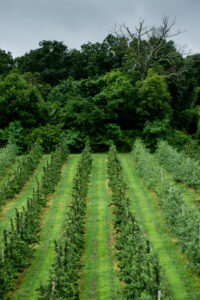 May 31, 2022
May 31, 2022
Codling moth degree-day accumulations range from about 550 in Henderson County to 755 in Cleveland County, which equates to completion of about 30% and 60% first generation egg hatch. First generation codling moth can continue to be a threat through about 900 DD after biofix, so the next two weeks is an important time for management in Henderson County and at similar or higher elevations. In lower elevation orchards such as Cleveland County, first generation egg hatch will be nearly complete in the next week. In the absence of pheromone trapping, one should assume a threat exists.
Tufted apple bud moth DD accumulations range from 740 in Henderson County to 967 in Cleveland County. Excellent control can be achieved with a single insecticide application made any time between 800 and 1200 DD. Hence, we are essentially in that window of opportunity now. Insecticides recommended for codling moth are also effective against TABM, with Altacor, Exirel, Verdepryn, Delegate and Intrepid most effective.
Learn more about southeastern apple insect pests at the Apple Insect Management page.
2022 Average Weekly Trap Captures
| HENDERSON COUNTY | |||
| Insects per trap | |||
| May 16 | May 23 | May 31 | |
| Codling moth | 2.0 | 1.0 | 0.5 |
| Oriental fruit moth | 3.0 | 4.5 | 3.5 |
| Tufted apple bud moth | 18.0 | 42.0 | 24.0 |
| Redbanded leafroller | 0.0 | 0.0 | 0.0 |
| Obliquebanded leafroller | 0.0 | 6.0 | 4.0 |
| Lesser appleworm | 10.0 | 5.0 | 0.0 |
| Apple maggot (abandoned and research orchards) | – | – | – |
| Brown marmorated stink bug (commercial) | – | – | – |
| Brown marmorated stink bug (unsprayed) | 0.0 | 1.0 | 0.5 |
| Spotted tentiform leafminer | 0.0 | 0.0 | 0.0 |
| Dogwood borer | 38.0 | 80.0 | 82.0 |
| Peachtree borer | 0.0 | 0.0 | 2.0 |
| Lesser peachtree borer | 18.0 | 28.0 | 9.0 |
| San Jose scale | 0.0 | 0.0 | 0.0 |
| Ambrosia beetle (all species) | 2.0 | 6.3 | . |
*Note that these averages illustrate only the timing of insect emergence and fluctuations in populations, and are not representative of population levels in any given orchard. The only way to have an accurate assessment of an individual orchard’s populations is to set up traps in that orchard.
2022 Accumulated Degree Days
| HENDERSON COUNTY | ||||
| May 16 | May 23 | May 31 | ||
| Codling moth (Biofix: April 22) | 296 | 429 | 555 | |
| Oriental fruit moth (Biofix: April 12) | 519 | 686 | 852 | |
| Tufted apple bud moth (Biofix: April 27) | 321 | 488 | 655 | |
May 24, 2022
 Codling moth remains the key insect of concern at this time. Egg hatch degree-day (DD) model accumulations range from about 440 DD in Henderson County to 600 in Cleveland County. While first-generation codling moth can potentially be a concern up until 800 to 1000 DD, depending on population density, the most critical period for protection is typically between about 300 to 800 DD. Rain, cool nights and moderate daytime temperatures over the next 4 to 5 days will likely suppress moth activity.
Codling moth remains the key insect of concern at this time. Egg hatch degree-day (DD) model accumulations range from about 440 DD in Henderson County to 600 in Cleveland County. While first-generation codling moth can potentially be a concern up until 800 to 1000 DD, depending on population density, the most critical period for protection is typically between about 300 to 800 DD. Rain, cool nights and moderate daytime temperatures over the next 4 to 5 days will likely suppress moth activity.
Tufted Apple Bud Moth (TABM): In lower elevation orchards (<1000 ft) we are approaching the wide window of opportunity for tufted apple bud moth control. Control of this leafroller is easily achieved with one application of a recommended insecticide anytime between 800 and 1200 DD after biofix. DD accumulations range from about 590 in Henderson County to 800 in Cleveland County. In lower elevation orchards control of this generation can be achieved with an application anytime between now and the first week of June. In Henderson County, where TABM populations are generally the highest in this region, the window for control is expected to be during the first two weeks of June. For those monitoring TABM activity, it is important to remember that egg laying does not begin until pheromone trap captures peak, so do not be concerned about high trap captures at this time.
Learn more about southeastern apple insect pests at the Apple Insect Management page.
2022 Average Weekly Trap Captures
| HENDERSON COUNTY | |||
| Insects per trap | |||
| May 9 | May 16 | May 23 | |
| Codling moth | 4.0 | 2.0 | 1.0 |
| Oriental fruit moth | 9.0 | 3.0 | 4.5 |
| Tufted apple bud moth | 16.0 | 18.0 | 42.0 |
| Redbanded leafroller | 0.0 | 0.0 | 0.0 |
| Obliquebanded leafroller | 0.0 | 0.0 | 6.0 |
| Lesser appleworm | – | 10.0 | 5.0 |
| Apple maggot (abandoned and research orchards) | – | – | – |
| Brown marmorated stink bug (commercial) | – | – | – |
| Brown marmorated stink bug (unsprayed) | 0.0 | 0.0 | 1.0 |
| Spotted tentiform leafminer | 0.0 | 0.0 | 0.0 |
| Dogwood borer | 7.0 | 38.0 | 80.0 |
| Peachtree borer | 0.0 | 0.0 | 0.0 |
| Lesser peachtree borer | 33.0 | 18.0 | 28.0 |
| San Jose scale | 0.0 | 0.0 | 0.0 |
| Ambrosia beetle (all species) | 1.3 | 2.0 | 6.3 |
*Note that these averages illustrate only the timing of insect emergence and fluctuations in populations, and are not representative of population levels in any given orchard. The only way to have an accurate assessment of an individual orchard’s populations is to set up traps in that orchard.
2022 Accumulated Degree Days
| HENDERSON COUNTY | ||||
| May 9 | May 16 | May 23 | ||
| Codling moth (Biofix: April 22) | 200 | 296 | 429 | |
| Oriental fruit moth (Biofix: April 12) | 390 | 519 | 686 | |
| Tufted apple bud moth (Biofix: April 27) | 193 | 321 | 488 | |
May 17, 2022
Codling Moth, European Red Mite
Codling moth remains the key pest that poses a threat to apples. This is also a time to consider a preventive miticide application for those using this approach in specific orchards or cultivars.
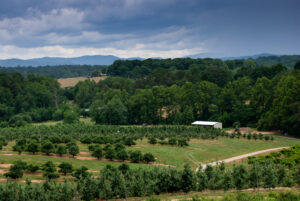 Codling Moth
Codling Moth
Egg hatch degree-day models range from about 300 DD in Henderson County to about 440 DD in lower-elevation Cleveland County. In Henderson County, this week is optimum timing for an initial insecticide in orchards with historically low population densities. In orchards with moderate to high populations of codling moth, last week was optimum timing for the first insecticide application. In orchards using mating disruption, it is doubtful that an insecticide is necessary unless pheromone traps are consistently capturing moths.
In orchards at lower elevations where DD accumulations are greater than 400, applications at this time should be based on intensity of moth captures in pheromone traps. If there is no trapping being conducted, it would be wise to assume populations are high and to make a total of 3 applications at 2-week intervals during the first generation. In lower-elevation orchards using mating disruption for codling moth, it is recommended that a single insecticide be applied against the first generation codling moth. This application should coincide with tufted apple bud moth DD accumulations reaching about 800, which is expected to occur next early next week.
Preventive Control of European Red Mite
In orchards with a history or European red mite problems, several options are available for preventive control that usually provides season-long suppression. These include Apollo, Savey, Zeal, Envidor and Agri-Mek. For resistance management purposes, rotate products with different modes of action annually. Apollo and Savey are the same mode of action (MOA group 10A), so do not use either of these in successive years. Agri-Mek should be applied at petal fall to first cover, and either a horticultural oil or penetrating adjuvant should be used to maximize uptake by leaves – if using oil do not use within 14 days of using Captan.
Learn more about southeastern apple insect pests at the Apple Insect Management page.
2022 Average Weekly Trap Captures
| HENDERSON COUNTY | |||
| Insects per trap | |||
| May 2 | May 9 | May 16 | |
| Codling moth | 12.0 | 4.0 | 2.0 |
| Oriental fruit moth | 12.0 | 9.0 | 3.0 |
| Tufted apple bud moth | 7.0 | 16.0 | 18.0 |
| Redbanded leafroller | 0.0 | 0.0 | 0.0 |
| Obliquebanded leafroller | 0.0 | 0.0 | 0.0 |
| Lesser appleworm | – | – | 0.0 |
| Apple maggot (abandoned and research orchards) | – | – | – |
| Brown marmorated stink bug (commercial) | – | – | – |
| Brown marmorated stink bug (unsprayed) | 1.0 | 0.0 | 0.0 |
| Spotted tentiform leafminer | 0.0 | 0.0 | 0.0 |
| Dogwood borer | 0.0 | 7.0 | 38.0 |
| Peachtree borer | 0.0 | 0.0 | 0.0 |
| Lesser peachtree borer | 45.0 | 33.0 | 18.0 |
| San Jose scale | 0.0 | 0.0 | 0.0 |
| Ambrosia beetle (all species) | 2.3 | 1.3 | 2.0 |
*Note that these averages illustrate only the timing of insect emergence and fluctuations in populations, and are not representative of population levels in any given orchard. The only way to have an accurate assessment of an individual orchard’s populations is to set up traps in that orchard.
2022 Accumulated Degree Days
| HENDERSON COUNTY | ||||
| May 2 | May 9 | May 16 | ||
| Codling moth (Biofix: April 22) | 104 | 200 | 296 | |
| Oriental fruit moth (Biofix: April 12) | 260 | 390 | 519 | |
| Tufted apple bud moth (Biofix: April 27) | 62 | 193 | 321 | |
May 10, 2022
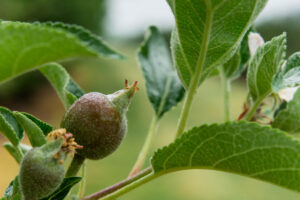 Codling Moth and San Jose Scale
Codling Moth and San Jose Scale
With petal fall sprays complete, the insects of interest during the next few weeks are first generation codling moth and San Jose scale. San Jose scale management options were discussed in last week’s update.
Codling Moth
The codling moth degree-day (DD) model is an excellent tool for timing insecticide applications, while pheromone trap captures can help determine the frequency of applications over the next three to four weeks. Under moderate to high populations, which are usually associated with some damage the previous year and pheromone trap captures greater than 5 to 10 per week, an initial insecticide application should be made about 250 DD after biofix. Under low population densities, initial application can be delayed until about 350 DD. Biofix in Cleveland County (1000 ft elevation) and Henderson County (2000 ft elevation) occurred on 15 and 22 April, respectively. Wilkes County is generally between these dates, depending on elevation of the orchard. As of 9 May, cumulative DD were 340 DD in Cleveland Co. and 210 in Henderson Co. NOTE: In orchards using mating disruption for codling moth, a single insecticide application at approximately 600 DD is recommended, which will coincide with timing for tufted apple bud moth.
To help avoid the development of insecticide resistance, it is important to use different modes of action against first and second generation (which occurs in July) codling moth. For instance, if a MOA group 28 insecticide is used (e.g., Altacor, Exirel, or Verdepryn) against the first generation, regardless of how many times it is applied, do not use any of these insecticides against the second generation in July. Alternatively, if Delegate (MOA group 5) is used for first generation control, do not use this product in July. While these two groups have the highest efficacy ratings against codling moth, other insecticides that will provide good control under low to moderate populations include Assail, Intrepid, Imidan, and Rimon. The rotation stipulation also holds for use of these insecticides, so if one of these products is used during the first generation, it should not be used in July, and vice versa.
Learn more about southeastern apple insect pests at the Apple Insect Management page.
2022 Average Weekly Trap Captures
| HENDERSON COUNTY | |||
| Insects per trap | |||
| Apr 25 | May 2 | May 9 | |
| Codling moth | 8.0 | 12.0 | 4.0 |
| Oriental fruit moth | 10.0 | 12.0 | 9.0 |
| Tufted apple bud moth | 0.0 | 7.0 | 16.0 |
| Redbanded leafroller | 0.0 | 0.0 | 0.0 |
| Obliquebanded leafroller | 0.0 | 0.0 | 0.0 |
| Lesser appleworm | – | – | – |
| Apple maggot (abandoned and research orchards) | – | – | – |
| Brown marmorated stink bug (commercial) | – | – | – |
| Brown marmorated stink bug (unsprayed) | 0.5 | 1.0 | 0.0 |
| Spotted tentiform leafminer | 0.0 | 0.0 | 0.0 |
| Dogwood borer | 0.0 | 0.0 | 7.0 |
| Peachtree borer | 0.0 | 0.0 | 0.0 |
| Lesser peachtree borer | 24.0 | 45.0 | 33.0 |
| San Jose scale | 0.0 | 0.0 | 0.0 |
| Ambrosia beetle (all species) | 2.0 | 2.3 | 1.3 |
*Note that these averages illustrate only the timing of insect emergence and fluctuations in populations, and are not representative of population levels in any given orchard. The only way to have an accurate assessment of an individual orchard’s populations is to set up traps in that orchard.
2022 Accumulated Degree Days
| HENDERSON COUNTY | ||||
| Apr 25 | May 2 | May 9 | ||
| Codling moth (Biofix: April 22) | 41 | 104 | 200 | |
| Oriental fruit moth (Biofix: April 12) | 172 | 260 | 390 | |
| Tufted apple bud moth (Biofix: April 27) | – | 62 | 193 | |
May 3, 2022
 Petal Fall to First Cover Sprays
Petal Fall to First Cover Sprays
Depending on location, some are still applying petal fall sprays and others are approaching first cover. Last week’s update focused on petal fall and the importance of choosing an insecticide effective against plum curculio and oriental fruit moth. However, there have been some questions about the efficacy of insecticides recommended at petal fall against green fruitworm, which was not included in the relative efficacy table because of its sporadic occurrence. Nonetheless, any insecticide with a rating of 4 or more against oriental fruit moth is also highly effective against green fruitworm, including Assail, Imidan, Verdepryn and Voliam Flexi.
As we approach the first cover spray, attention will turn to the codling moth and San Jose scale.
Codling moth
Biofix for the codling moth degree-day model was set as 22 April at the Mountain Horticultural Crops Research Station in Mills River (elevation 2,067 ft). Biofix in lower elevation orchards such as Cleveland County generally occurs about one week earlier. As of today (3 May), about 120 DD have accumulated in Henderson County. In Cleveland County, assuming a biofix date of 15 April, approximately 220 DD have accumulated.
In orchards with moderate to high codling moth populations, an initial insecticide application should be made at 250 DD, which will occur later this week in lower elevation orchards (about 1000 ft). At higher elevations, such as Henderson County (about 2,000 ft), 250 DD is predicted to occur in 8 to 10 days. However, in orchards with low codling moth populations, initial insecticide applications can wait until about 350 DD. Finally, insecticides targeting first generation codling moth are generally not needed in orchards using mating disruption for codling moth, but monitoring with pheromone traps can help determine if a supplemental application is needed.
Next week’s update will focus on codling moth insecticide options and resistance management strategies.
San Jose Scale (SJS)
With prebloom Lorsban (chlorpyifos) no longer an option for San Jose scale, greater focus is now placed on timing applications for emergence of first generation crawlers, which occurs near the first cover spray (see figure below).
Two commonly used and excellent materials for SJS are Esteem and Centaur, and for resistance management they should be rotated annually. It should also be noted that under low codling moth pressure Esteem will also serve as an effective codling moth control, primarily due to its ovicidal activity. Other insecticides that will provide good control of SJS at first cover include Diazinon 50W, Assail, and Movento.
Learn more about southeastern apple insect pests at the Apple Insect Management page.
2022 Average Weekly Trap Captures
| HENDERSON COUNTY | |||
| Insects per trap | |||
| Apr 20 | Apr 25 | May 2 | |
| Codling moth | 0.0 | 8.0 | 12.0 |
| Oriental fruit moth | 21.0 | 10.0 | 12.0 |
| Tufted apple bud moth | 0.0 | 0.0 | 7.0 |
| Redbanded leafroller | 3.0 | 0.0 | 0.0 |
| Obliquebanded leafroller | 0.0 | 0.0 | 0.0 |
| Lesser appleworm | – | – | – |
| Apple maggot (abandoned and research orchards) | – | – | – |
| Brown marmorated stink bug (commercial) | – | – | – |
| Brown marmorated stink bug (unsprayed) | 0.0 | 0.5 | 1.0 |
| Spotted tentiform leafminer | 0.0 | 0.0 | 0.0 |
| Dogwood borer | 0.0 | 0.0 | 0.0 |
| Peachtree borer | 0.0 | 0.0 | 0.0 |
| Lesser peachtree borer | 6.0 | 24.0 | 45.0 |
| San Jose scale | 0.0 | 0.0 | 0.0 |
| Ambrosia beetle (all species) | 11.0 | 3.5 | 1.5 |
*Note that these averages illustrate only the timing of insect emergence and fluctuations in populations, and are not representative of population levels in any given orchard. The only way to have an accurate assessment of an individual orchard’s populations is to set up traps in that orchard.
2022 Accumulated Degree Days
| HENDERSON COUNTY | ||||
| Apr 20 | Apr 25 | May 2 | ||
| Codling moth (Biofix: April 22) | – | 41 | 104 | |
| Oriental fruit moth (Biofix: April 12) | 87 | 172 | 260 | |
| Tufted apple bud moth (Biofix: April 27) | – | – | 62 | |
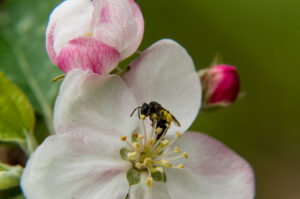 April 26, 2022
April 26, 2022
Petal Fall Spray Options
Insects to be targeted with insecticide sprays at petal fall include Plum Curculio, and possibly Oriental Fruit Moth (OFM), and Rosy Apple Aphid. The need for control of the latter two is dependent on what, if any, insecticide was applied before bloom. Prebloom insecticide sprays typically target rosy apple aphid and San Jose scale, but since they can both be controlled at petal fall or first cover with the proper selection of insecticide(s), prebloom insecticide sprays usually are not necessary. (Note: oil at green tip is always recommended to suppress European red mite and San Jose scale populations and reduce risk of infestations later in the season). Finally, if mating disruption is being used for OFM and codling moth, OFM control with insecticides is not necessary.
Plum Curculio: This remains one of the most common causes of insect damage to apples in this region, and effective control is highly correlated with petal fall sprays. Although the severity of damage varies considerably among orchards, plum curculio is ubiquitous and can cause damage in virtually every orchard. In orchards with a history of problems, sprays should be made as quickly after petal fall as possible. In orchards where damage is historically low, there is usually a longer buffer period and sprays can be slightly delayed. However, 1st Cover is often too long to wait.
Rosy Apple Aphid: Rosy apple aphid is a sporadic pest, but it can be difficult to monitor and control with curative applications of insecticides. Most neonicotinoids and closely related insecticides are effective against RAA, and effective control can be achieved before bloom at Pink, or after bloom at petal fall.
Oriental Fruit Moth: Biofix at the research station in Henderson County was set on 12 April, and off the mountain in Cleveland County it typically occurs about one week earlier. In orchards using mating disruption for OFM, insecticidal control of the first generation is not necessary, so focus on plum curculio and rosy apple aphid if relevant. However, where mating disruption is not used, an insecticide effective against this pest is recommended to control the first generation.
Insecticide Options: Because of the importance of plum curculio, only those insecticides with activity against this pest are recommended at petal fall. Below is a table of depicting the relative efficacy of various insecticides targeting pests at petal fall. San Jose scale and preventive control of European red mite are not included here, because 1st Cover is generally a more effective timing. Also, insecticides that may aggravate San Jose scale or European red mite populations (mostly pyrethroids) are not recommended at petal fall.
Relative Efficacy of Insecticides for Petal Fall |
||||
| (─ no activity, 1 = least effective, 5 = most effective) | ||||
| Insecticide (active ingredient) | Plum Curculio | Rosy Apple Aphid | Oriental Fruit Moth | European Red Mite |
| Actara (thiamethoxam) | 5 | 5 | 2 | ─ |
| Assail (acetamiprid) | 3 | 5 | 4 | ─ |
| Belay (chlothianidin) | 4 | 5 | 3 | ─ |
| Avaunt (Indoxacarb) | 4 | ─ | 4 | ─ |
| Imidan (phosmet) | 5 | ─ | 4 | ─ |
| Verdepryn (cyclaniliprole) | 4 | ─ | 5 | ─ |
| Agri-Flex (abamectin + thiamethoxam) | 5 | 5 | 2 | 5 |
| Voliam Flexi (thiamethoxam + chlorantraniliprole) | 5 | 5 | 5 | ─ |
Learn more about southeastern apple insect pests at the Apple Insect Management page.
2022 Average Weekly Trap Captures
| HENDERSON COUNTY | |||
| Insects per trap | |||
| Apr 12 | Apr 20 | Apr 25 | |
| Codling moth | 0.0 | 0.0 | 8.0 |
| Oriental fruit moth | 12.0 | 21.0 | 10.0 |
| Tufted apple bud moth | 0.0 | 0.0 | 0.0 |
| Redbanded leafroller | 2.0 | 3.0 | 0.0 |
| Obliquebanded leafroller | 0.0 | 0.0 | 0.0 |
| Lesser appleworm | – | – | – |
| Apple maggot (abandoned and research orchards) | – | – | – |
| Brown marmorated stink bug (commercial) | – | – | – |
| Brown marmorated stink bug (unsprayed) | 0.0 | 0.0 | 0.5 |
| Spotted tentiform leafminer | 2.0 | 0.0 | 0.0 |
| Dogwood borer | 0.0 | 0.0 | 0.0 |
| Peachtree borer | 0.0 | 0.0 | 0.0 |
| Lesser peachtree borer | 1.0 | 6.0 | 24.0 |
| San Jose scale | 0.0 | 0.0 | 0.0 |
| Ambrosia beetle (all species) | 2.0 | 11.0 | 3.5 |
*Note that these averages illustrate only the timing of insect emergence and fluctuations in populations, and are not representative of population levels in any given orchard. The only way to have an accurate assessment of an individual orchard’s populations is to set up traps in that orchard.
2022 Accumulated Degree Days
| HENDERSON COUNTY | ||||
| Apr 12 | Apr 20 | Apr 25 | ||
| Codling moth (Biofix: April 22) | – | – | 41 | |
| Oriental fruit moth (Biofix: April 12) | 0 | 87 | 172 | |
| Tufted apple bud moth (Biofix TBD) | – | – | – | |
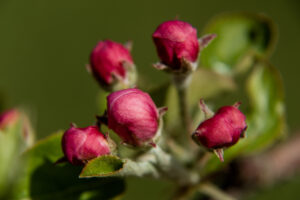 April 5, 2022
April 5, 2022
Learn more about southeastern apple insect pests at the Apple Insect Management page.
2022 Average Weekly Trap Captures
| HENDERSON COUNTY | |||
| Insects per trap | |||
| Mar 21 | Mar 28 | Apr 4 | |
| Codling moth | – | – | setup |
| Oriental fruit moth | 0.0 | 2.0 | 0.0 |
| Tufted apple bud moth | – | – | setup |
| Redbanded leafroller | 8.0 | 1.0 | 2.0 |
| Obliquebanded leafroller | – | – | setup |
| Lesser appleworm | – | – | – |
| Apple maggot (abandoned and research orchards) | – | – | – |
| Brown marmorated stink bug (commercial) | – | – | – |
| Brown marmorated stink bug (unsprayed) | – | – | setup |
| Spotted tentiform leafminer | – | – | setup |
| Dogwood borer | – | – | setup |
| Peachtree borer | – | – | setup |
| Lesser peachtree borer | – | – | setup |
| San Jose scale | – | – | setup |
| Ambrosia beetle (all species) | 0.0 | 1.5 | 0.0 |
*Note that these averages illustrate only the timing of insect emergence and fluctuations in populations, and are not representative of population levels in any given orchard. The only way to have an accurate assessment of an individual orchard’s populations is to set up traps in that orchard.
2022 Accumulated Degree Days
| HENDERSON COUNTY | ||||
| Codling moth (Biofix TBD) | n/a | |||
| Oriental fruit moth (Biofix TBD) | n/a | |||
| Tufted apple bud moth (Biofix TBD) | n/a | |||



